Bloody Sunday: cock-up or conspiracy?
Published in 20th-century / Contemporary History, Features, Issue 5 (Sept/Oct 2010), Troubles in Northern Ireland, Volume 18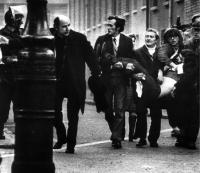
Father (later Bishop) Edward Daly waving a bloody handkerchief as he and several others carry the fatally wounded seventeen-year-old Jackie Duddy past British soldiers on Bloody Sunday. (Stanley Matchett)
The most illuminating evidence that we have of high-level military decision-making in relation to Bloody Sunday is contained in a series of interviews conducted in 1983 and 1984 by Desmond Hamill for a book that he was writing about the British Army in Northern Ireland. Hamill’s interviews with the key military figures involved were conducted at a time when Bloody Sunday seemed safely confined to the past and well before the spectre of a second inquiry prompted a return to terse and narrowly legally defensible accounts of the event. General Sir Robert Ford, the architect of the Bloody Sunday operation, described to Hamill in some detail how he had contacted the Derry Brigade commander, ‘Pat’ MacLellan, who had direct responsibility for the army operation that day, and told him to ‘get a move on’, to issue the order to send the Paras in to the Bogside. The figure at the other end of that purported call, Brigadier MacLellan, also recalled this conversation in his interview with Hamill. If the Saville inquiry had established that this conversation had taken place, it could hardly have failed to conclude that General Ford had improperly interfered with the chain of command and effectively forced the local commander to order the operation. It would have directly and immediately implicated Ford, and thus the top level of military command in Northern Ireland, in the killings.
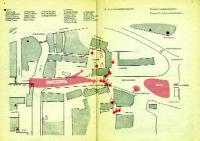 When it came to the Saville inquiry, however, both Ford and MacLellan said they now believed that they were mistaken or had no confidence in this recollection. On the face of it this seems like a blatant attempt to cover up a devastatingly incriminating piece of evidence inadvertently released at a time when it seemed that Bloody Sunday had moved beyond the law and into the realm of history. But the inquiry, which examined communication logs and the technicalities of communication equipment at the time in exhaustive detail, found no evidence that this conversation had taken place. The conversation was, it seems, a false memory, shared by the two most senior pivotal figures involved in the event. But this ‘somewhat curious mistake’, as counsel to the inquiry called it, is much more than a curiosity and it enhances rather than detracts from our knowledge of Bloody Sunday.
When it came to the Saville inquiry, however, both Ford and MacLellan said they now believed that they were mistaken or had no confidence in this recollection. On the face of it this seems like a blatant attempt to cover up a devastatingly incriminating piece of evidence inadvertently released at a time when it seemed that Bloody Sunday had moved beyond the law and into the realm of history. But the inquiry, which examined communication logs and the technicalities of communication equipment at the time in exhaustive detail, found no evidence that this conversation had taken place. The conversation was, it seems, a false memory, shared by the two most senior pivotal figures involved in the event. But this ‘somewhat curious mistake’, as counsel to the inquiry called it, is much more than a curiosity and it enhances rather than detracts from our knowledge of Bloody Sunday.
This shared memory of a straightforward act of communication symbolises a much more complex process. It symbolises the intense pressure to stage a large-scale confrontation that Ford had placed on MacLellan, and their shared understanding that pressure from the general was crucial to MacLellan’s decision to order the Paras in against his own better judgement. The way in which that pressure from above was actually manifested says much about the relationship between high-level decision-making and the actions of the soldiers on the ground that day.
Ford planned for confrontation
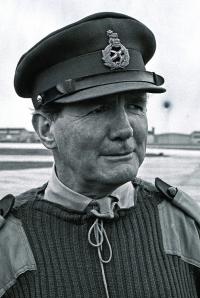
As Commander Land Forces (CLF), General Sir Robert Ford (above) was in charge of day-to-day operations in Northern Ireland. Ford served as a deputy to the General Officer Commanding (GOC), General Sir Harry Tuzo, and had no formal responsibility for policy decisions. Yet Ford’s evidence to the inquiry made clear that he was deeply involved in policy discussions and that Tuzo kept him informed in minute detail of the political discussions taking place in London. He also had strong views on policy issues, and was significantly more enthusiastic about repression than other senior military figures at the time. It was he who decided to use the Paras to launch a massive arrest operation in Derry on the day of the civil rights march.
As commander of 8 Brigade, one of three army brigades in Northern Ireland, Brigadier Andrew ‘Pat’ MacLellan was in command of military forces in Derry and surrounding areas. MacLellan worked closely with RUC Chief Superintendent Frank Lagan and shared Lagan’s broadly conciliatory attitude. MacLellan was under the operational command of the CLF, General Ford, but dealt directly with the GOC, General Tuzo, in relation to policy decisions. (Victor Patterson)
General Ford’s initial concept for the operation was to stage a massive confrontation in Derry by launching an arrest operation on a scale far beyond anything the city had seen before. The occasion chosen for this initiative—a civil rights march—was one on which the danger of civilian deaths and injuries from such an operation was exceptionally high. MacLellan, under the influence of a strongly conciliatory local police chief, Frank Lagan, but also with explicit endorsement from the British government, had been operating a policy of relative restraint in Derry, as had his predecessor. General Ford and other senior military figures in Northern Ireland were deeply unhappy with this, and Ford in particular was arguing at the time for a much more aggressive approach in the city. The planned civil rights march provided the general with an opportunity to order a massive confrontational operation that could be characterised as a responsive operational decision.
In the meeting at which Ford first ordered MacLellan to launch the arrest operation by the Paras he applied intense pressure, issuing a direct order that the Paras be sent in if soldiers were confronted by rioters, as they inevitably would be. There was no discussion of the possibility of civilian casualties. If MacLellan failed to launch the operation on the day on the basis that the danger of civilian casualties was unacceptably high, he left himself open to the accusation that he had disobeyed a direct order from a superior.
Presure on MacLellan
How, then, was the pressure that Ford applied to MacLellan before the day manifested on the day itself if it didn’t take the form of a direct oral communication? The pressure from the top to stage a major confrontation in Derry was in fact manifested not in one call but in a series of oral communications to MacLellan in the minutes before he finally gave the order to go in, but they didn’t come from General Ford. They came, instead, at first or second hand, from the commanders of the Paras. The Paras, the ‘toughest’ regiment in the British army, had killed several unarmed civilians in Belfast in disputed circumstances over the previous months and had been personally selected by Ford for the Derry operation. The commander of 1 Para, Colonel Derek Wilford, was fully in tune with Ford’s view of the restraint policy in Derry as unacceptable. The Paras were formally under the command that day of MacLellan, but Wilford was aware that the Paras were there in opposition to the policy of restraint with which MacLellan was associated. Their mandate to launch a ‘hard’ operation that day derived not from MacLellan but from General Ford and thus came from the top of the military command structure in Northern Ireland.
At 3.30pm on Bloody Sunday, as marchers crowded into William Street and rioting broke out, Para commanders told C Company of 1 Para to get ready to move through the barriers. The Paras were clearly expecting to get the order to go in at any moment. Several minutes later General Ford arrived at barrier 14, where some of the Paras were waiting to go in, and remained there throughout the following series of communications. Over the following twenty minutes water cannon and rubber bullets were used against rioters and the number of people left in William Street was reduced dramatically. If the Paras didn’t go in soon it would be too late for them to go in at all. At 3.55pm Colonel Wilford informed MacLellan at brigade headquarters that they had ‘deployed… units slightly forward . . . in preparation for any orders which you may have’. Having waited almost half an hour for the order to go in, Wilford was now implicitly requesting an order. MacLellan declined to issue one. Just a few minutes later Wilford followed up his implicit request for orders to launch the operation with an explicit request to MacLellan: ‘Would like to deploy sub-unit through barricade 14 to pick up yobbos in William Street/Little James Street’. MacLellan then refused this explicit request. By this stage rioting was beginning to die down and there was a distinct possibility that the opportunity to launch the operation was about to pass. It is difficult to avoid the conclusion that MacLellan was hoping that he would be able to avoid issuing the order at all.
It was tricky enough for MacLellan to quietly avoid issuing an order until the point at which the operation was no longer feasible. But to resist repeated requests for orders from the Paras when General Ford and the commander of 1 Para already regarded him as too conciliatory was quite another matter. The fact that Ford was on the ground with the Paras at this stage reinforced the understanding on all sides that the proposed operation enjoyed his direct personal endorsement.
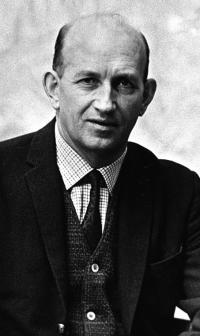
Appointed to head the RUC in Derry in June 1970, RUC Chief Superintendent Frank Lagan (above) built extensive links with a wide range of forces in the Catholic community in Derry, including Official Republicans. Opposed to the intensification of repression in 1971, he was the key advocate within the security forces of a policy of restraint in Derry. He initially proposed that the civil rights march be allowed to proceed unhindered to its destination and made intensive efforts to avert confrontation on the day. (Victor Patterson)
‘The Paras want to go in’
It was clear that MacLellan was feeling the pressure at this stage. Just after he refused Wilford’s request, at about 4pm, MacLellan went into the office where RUC Chief Superintendent Frank Lagan was based throughout the afternoon and told Lagan ‘The Paras want to go in’. On the face of things it was a peculiar statement. The Paras were entirely subordinate to MacLellan. In formal, legal terms it ultimately didn’t matter one whit whether the troops on the ground wanted to go in or not. But the fact that the operation was an initiative of General Ford’s gave a particular meaning to the pressure from the Paras. In refusing the Paras, MacLellan was effectively refusing General Ford.
At 4.02pm the Paras called another unit and asked: ‘Is there still a hooligan element in the area of William Street/Little James Street and around Barrier 14?’ When the other unit replied in the affirmative, the Paras said: ‘Would you mind informing zero [brigade headquarters] of this, as they don’t seem to believe us on this point’. By this stage the Paras were effectively engaging in argument, at second hand, with MacLellan and were making another move aimed at increasing the pressure on him to issue the order. At 4.03–4pm this other unit duly called brigade HQ to say that ‘hooligans’ were still around.
The fact that the Paras felt they could behave in such a ‘cheeky’ fashion (as one officer put it in evidence to the inquiry) cannot be understood in isolation. Crucial to these repeated attempts to pressure a senior officer to issue orders was the understanding that the Paras enjoyed a mandate from the very top to disrupt the local policy of restraint with which that commander was associated. When both General Ford and Brigadier MacLellan later recalled a crucial conversation in which Ford had urged the latter to issue the order, they were expressing a shared understanding that the calls from the Paras were a form of direct pressure on MacLellan that originated ultimately from General Ford.
The belief of the commander of 1 Para, Derek Wilford, that local commanders in Derry were too soft, the fact that he subsequently ignored restraining elements in the orders that MacLellan issued and the fact that individual Paras felt that they were operating in a context in which they could shoot unarmed civilians in the back and lying on the ground were not simply a product of their individual preferences or temperaments or views. They have to be understood in the context of a Bloody Sunday operation that originated in the strong opposition of senior military figures in Northern Ireland to the government-mandated policy of relative restraint in Derry.
At 4.07pm the order was finally given for the Paras to go in, an order that was extremely restrictive and that seems to have been aimed at minimising the impact of the operation. At 4.13pm, just three or four minutes after the Paras actually went in, brigade HQ ordered 1 Para: ‘If you have not conducted any scoop-up then you should withdraw your call sign [C Company] back to its original position for any further operation’. MacLellan had attempted to limit the operation to just a few minutes. But those few minutes were enough. By that stage the Paras had begun to fire.
MacLellan, not Wilford, out of sync with the intent of the operation
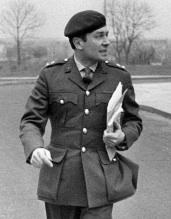
Colonel Derek Wilford (above) was commanding officer of 1 Para, based in Belfast, which was sent to Derry on Bloody Sunday to launch the major arrest operation devised by General Ford. Wilford’s Brigade Commander in Belfast was Frank Kitson, a counter-insurgency expert who had expressed his discontent with the restraint policy in Derry to General Ford.
Saville found that the restraining elements in the limited operation eventually ordered by MacLellan were ignored by Colonel Derek Wilford, and found Wilford culpable because he should have known that there was a high risk of civilian deaths if he ignored these limitations. But the deep thrust into the Bogside ordered by the Paras’ commander, with little evident concern for the danger to civilians, is entirely consistent with the confrontational intent evident in General Ford’s initial instructions to MacLellan. It seems clear, in fact, that in introducing an element of restraint it was MacLellan, rather than Wilford, who was out of sympathy and out of sync with the intent of the operation.
The killings on Bloody Sunday originated with a clear confrontational initiative planned at a high level, implemented determinedly by the soldiers on the ground in the face of resistance from a conciliatory local commander. The shared memory of a crucial phone call illustrates the shared understanding that pressure from the Paras on the ground to launch the operation was effectively pressure from the highest levels of military command. It helps us to connect the intention of confrontation evident at the highest levels of military command in Northern Ireland with the actions of the Paras on the ground that day.
There is work yet to be done in the other direction, in tracing the decision-making process upwards through the chain of command from that crucial meeting between Ford and MacLellan at which a major confrontation was ordered. How did a planned operation with such a clear confrontational intent, which went so directly against the thrust of formal British government policy in Derry, travel up through the layers of political and military control in Northern Ireland and in London? The Saville report did not critically analyse that process in any detail, but the inquiry has generated the evidence that will allow historians to do that work now. HI
Niall Ó Dochartaigh lectures in political science at NUI, Galway.
Further reading:
Closing Submission by Counsel to the Bloody Sunday Inquiry, Christopher Clarke QC (2004).
D. Hamill, Pig in the middle: the army in Northern Ireland 1969–84 (London, 1985).
N. Ó Dochartaigh, ‘Bloody Sunday: error or design?’, Contemporary British History 24 (1) (2010), 89–108.
A. Portelli, The death of Luigi Trastulli and other stories: form and meaning in oral history (Albany, 1991).
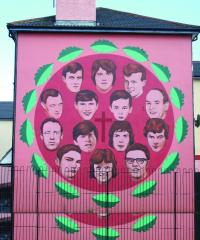
A mural to the victims in Derry’s Bogside.
















